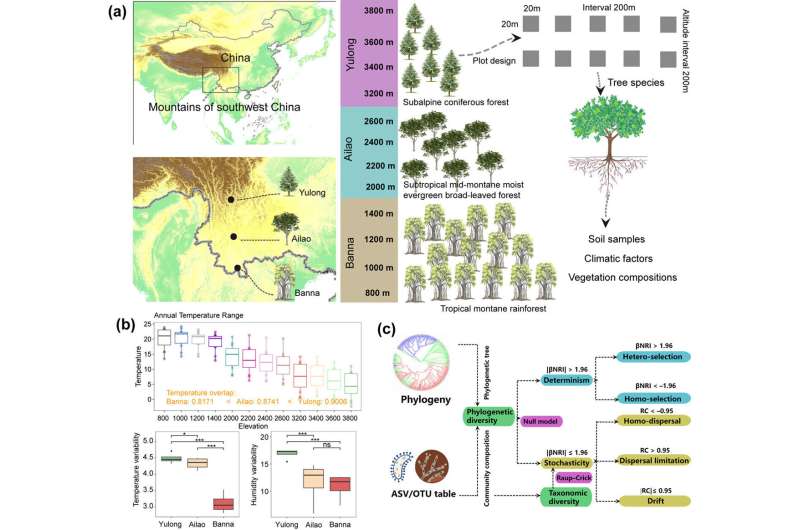This article has been reviewed according to Science X's editorial process and policies. Editors have highlighted the following attributes while ensuring the content's credibility:
fact-checked
peer-reviewed publication
trusted source
proofread
Research finds climate-dependent dispersal limitation plays an important role in mountain soil microbiome

Microbial communities are highly diverse, yet the mechanisms underlying microbial community assembly are not well understood. In 1967, Daniel Janzen hypothesized that low climatic variability along elevational gradients results in greater constraints on animal migration and plant dispersal for tropical taxa compared to temperate taxa.
In a study published
in Ecohydrology, researchers from the Xishuangbanna Tropical Botanical Garden (XTBG) of the Chinese Academy of Sciences and their collaborators sought to examine whether Janzen's mountain pass hypothesis applies to microorganisms, which would suggest that both dispersal limitation and environmental selection drive microbial β-diversity patterns. The researchers investigated changes in microbial community dissimilarities, distributional range sizes and ecological processes along elevational gradients in three montane ecosystems representing a gradient of climatic variability. They used
They found that climate (climate overlap and differences between elevations), degree of climate variability, and spatial distance played dominant roles in the pattern of microbial beta-diversity and the size of species distribution ranges along the elevational gradient.
They further found that mountainous areas with low climate variability and overlap had higher beta diversity and endemism, smaller species distribution ranges and steeper distance decay trends. However, all mountain microbiomes showed consistent climate-driven niche and dispersal-limiting processes, suggesting that the dispersal ability of mountain microbes is limited and strongly constrained by climatic conditions, so that microbial diversity is severely challenged in the context of climate change.
"Our study showed that the Janzen mountain hypothesis also applies to the community assembly process of microbial communities. It proved that climate-dependent dispersal limitation played an important role in the mountain soil microbiome," said Yang Jie of XTBG.
More information: Yazhou Zhang et al, Drivers and mechanisms that contribute to microbial β‐diversity patterns and range sizes in mountains across a climatic variability gradient, Ecography (2023). DOI: 10.1111/ecog.07049
Journal information: Ecography
Provided by Chinese Academy of Sciences
















